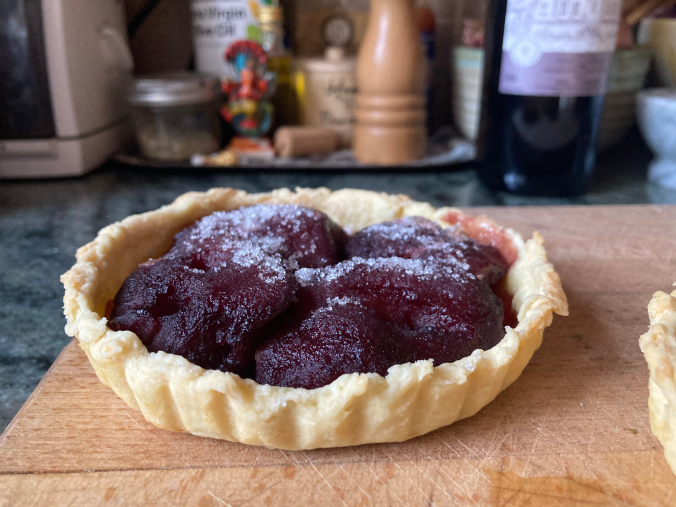Last week, I returned to a perennial favorite manuscript – UPenn Ms Codex 1601 – to do one of my favorite things – bake. This recipe to make a “tarte of Pippens” intrigued me because of the instruction to cook the pippins (apples) twice. First, you cook the apples in wine with spices, then you sprinkle them with sugar and bake them in pastry to make a tart. This was a dessert that I wanted to eat.
The Recipe
To make a tarte of Pippens.
68
Take faire pippens & pare them, then
cutt them in quarters & coure them, then
stew them with claret wine, sinamon &
ginger, let them stew halfe an houre, then
poure them into a cullender, but breake
them not, when they are cold, lay one
by one into the tart, then laie on sugar
bake itt, ice itt, scrape on sugar & serue itt.
On the page, this recipe affords the modern interpreter a great deal of flexibility. What kind of pippins or apples? How many apples? What kind of wine? How much cinnamon? Fresh or dried ginger? What kind of pastry? One large tart? Many small tarts? How much sugar?
The recipe calls for pippins. Although many heritage apple names include the word “pippin,” the recipe is likely meant to utilize apples that are only palatable after stewing in wine. “Pippins” broadly refers to apples grown from seeds, rather than cultivated by grafting. As I learned from Matt Kaminsky (Gnarly Pippins) last fall, these apples grown from seed were more likely to be small and tart, and they were traditionally sent to the cider press. If I had a crab apple tree, I would have tried crab apples in this recipe. Instead, I used Calville Blanc d’Hiver apples from Three Springs Fruit Farm. This French apple variety was first cultivated in the seventeenth century and it is prized for tarte tatin and other baked goods. When I realized they were available in my area, I bought a whole crate. (I’ve baked a lot of apple pies this fall and winter.) The apples held their shape beautifully when cooked in wine. If I didn’t have these apples in my fridge, I would have used Granny Smith because they would also hold up to cooking in wine and bring a sharp acidity to the dish.
I stewed the apples in a Bordeaux table wine (a nod to claret even though the style has changed so much since the seventeenth century) with cinnamon and fresh ginger (dried pieces of ginger would also have been an option). I decided to make two small tarts in fluted tart pans (5 inch) and used Julia Child’s sweet pastry recipe. You could easily make this as a galette – no tart pans required – or a larger, single tart by adjusting quantities accordingly.
Updated Recipe
Makes two small tarts baked in 5-inch tart pans.
2 apples
1 1/2 cups red wine
2 cinnamon sticks
2 inches fresh ginger, sliced
1 batch pastry (your choice)
2 Tablespoons sugar
Peel, quarter, and core the apples.
Put them in a small saucepan with the wine and spices. Bring to a boil, reduce to a simmer, and cook for 30 minutes.
While the apples are cooking, make your pastry and put it in your tart pans. Preheat the oven to 375F.
Strain the apples and set aside to cool for at least 10 minutes. (You can reserve the wine and spices for mulled wine.)
Place four cooked apple quarters in each pastry-lined tart pan. Sprinkle 1 tablespoon of sugar over the apples in each tart. Put the tarts on a baking sheet.
Bake for 35 minutes.
Let cook for 10 minus before removing the tarts from the pans.
The Results
Boozy, spicy, delicious. The apples were gorgeously colored and flavored by the wine. The scent of ginger and cinnamon accompanied every bite. Buttery pastry mellowed the sharpness from the apples and the bitterness of the wine. My spouse, Joseph, thought a creamy accompaniment – such as custard integrated into the tart or poured over, or ice cream – would perfect this dessert.
I reserved the cooking wine and whole spices. Reheated later, it made a lovely cup of mulled wine with a rich, apple flavor.
The tart was sweet from the apples and the sugar, but not too sweet. If you have a sweet-tooth, you may want to increase the sugar. The next day, I took a bite of the second tart and noticed most of the boozy and tannic flavors from the wine had mellowed. It made me wonder if resting the apples overnight might enhance their flavor before integrating them into the tart.
There are so many variables in the original recipe and I’ve written this updated version to give you flexibility. If you make tarts, I’d love to hear from you and I’m sure other readers would, too. Share what apples you’ve used and any other changes you’ve made in the comments below.




































You must be logged in to post a comment.